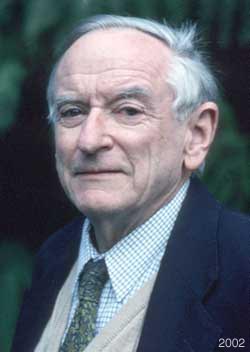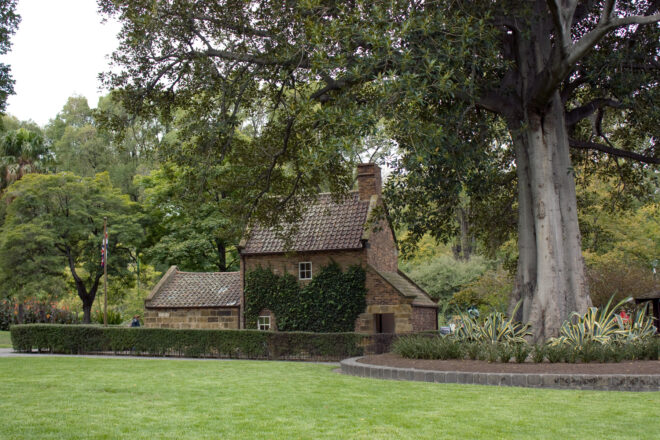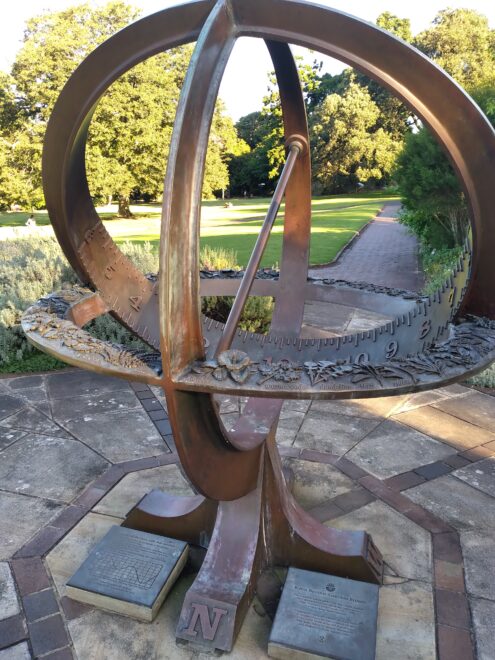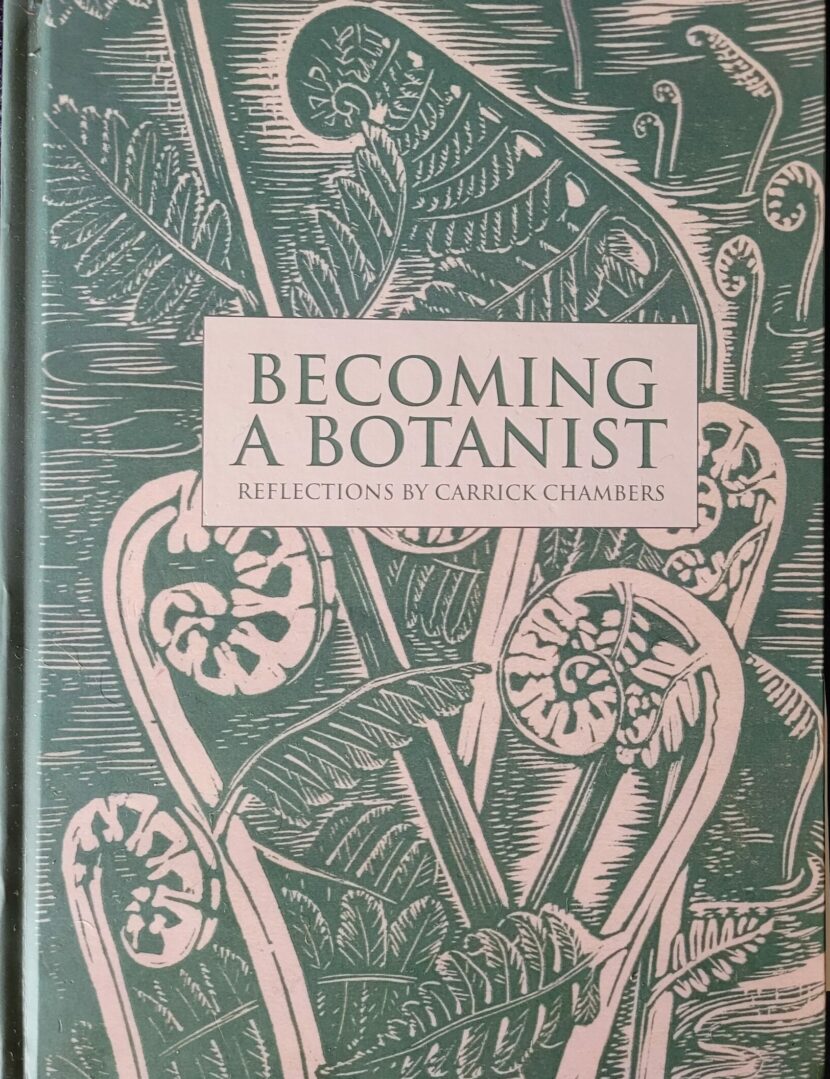Stuart Read reviews Becoming a botanist, by Carrick Chambers, with Claudia Chambers, hardback, limited edition, 2022
Available from the Friends of Royal Botanic Gardens Sydney, RRP $50 + postage, proceeds go to Wollemi pine research. Email, using subject: ‘botanist book order’ to: development@botanicgardens.nsw.gov.au with address and phone number

This lovely book is also deceptive. The touch is light, you don’t realise the range of subjects covered. A career combining Auckland, Sydney and Cambridge Universities, Professor of Botany at Melbourne, Director of Royal Botanic Gardens, Sydney is but brief overview.
Carrick and Margaret are probably known to Sydney and Melbourne AGHS members; they lived in both cities for decades. This book may see him better recognised for the pioneer and change agent he has been.
Their daughter Claudia recorded Carrick’s reminiscences over a decade, with editing by Margaret. A rich career is captured in six chapters: early years, botany studies, Melbourne life, Royal Botanic Gardens, Design and Discovery and Later Years. Chief Scientist, Dr Brett Summerell, provides an introduction, noting that only a special person can juggle serious botany and an ever-demanding public.
Photographer Jaime Plaza helped choose images from RBG Sydney’s archives. Carrick’s oral history interview in the RBG Sydney’s oral history project was mined.
I warmed to his Auckland childhood, and a photo of him, aged two, holding a dandelion next to grandmother. Born in 1930 and raised in the Great Depression, his father and mother rented a shop, running it as stationery shop and lending library. Growing up on volcanoes (Maungawhau/Mt Eden, The Three Kings) meant adventure – caves, heights. Working at about 10 years old for a nurseryman in holidays taught propagation and hybridisation. An interest in botany grew at The Intermediate School, which was surrounded by native flora and fauna. Display cases prepared by Auckland Museum toured schools. Carrick and a friend would also visit this museum, asking lots of questions to help identify holiday specimens.
Studies at Agricultural (Otahuhu Technical) College were interspersed with vegetable harvesting as part of the war effort. An inspirational teacher was Miriam Matthews, trained at Auckland’s Botany Department. She led camps in the Waitakere Ranges. Carrick’s father was a keen gardener and his son developed a fascination for growing sweet peas, and prizes. Teachers’ College followed because his mother was concerned science might not provide a career. At the prospect of teaching in a country town, he threw it in and headed for university to study science. Head of Botany, Valentine Chapman, was Cambridge-trained. Keen and active, he organised wonderful field club trips for students and staff on offshore islands and remote ranges, including the Central Plateau. Specimens were mounted, good ones kept in the Department’s herbarium.
Carrick’s masters was on classifying New Zealand ferns, especially the family Blechnaceae. This became a lifelong research interest, taking him to Africa, Australasia, the Pacific, China, Europe and Americas. Paying for study wasn’t easy – he had to work vacations in freezing works, on wharves and as a plumber’s assistant. Carrick spent a year as junior lecturer at Auckland University before coming to Sydney in 1956. He got a teaching fellowship, so he could study for his PhD at the University’s Botany Department.
He met Margaret in 1957. She was working the Botany School, while completing her B. Arts, plus for a professor in Bathurst and he University of New England (UNE) library. Her father was an eminent scientist and her mother, Dr Gwenda Davis, a botanist of renown at UNE. They were engaged in 1959, married in Armidale and moved back to Sydney. That year Carrick won a CSIRO postdoctoral scholarship to Cambridge to work at the Cavendish lab, training in electron microscopy, and in its Botany School.
Offered a post at the Botany Department of University of Melbourne in 1961, Carrick became Senior Lecturer (1964) and Professor (1967–88). By the 1980s the department had become one of the largest teaching-research ones in the Commonwealth. He continued research on electron microscopy and fine structures – plant viruses, paleo (fossil) botany and ferns. He supervised research students and took staff and students on field trips to explore parts of Victoria.
He instigated and chaired a Grounds Committee for the University for 16 years, laying out a program to re-landscaping the entire campus, which initially he found ‘scungy at best’. The underground car park was about to be built at its heart, requiring removal of an avenue of deciduous trees. Pausing work until they were dormant meant they were successfully relocated and reinstated afterwards as a new axial approach. Alec Brierley was appointed manager of horticulture in charge of planting, pruning, landscaping. Architect Bryce Mortlock (of Ancher, Mortlock and Woolley) developed a master plan – to transformative effect.
Carrick’s extra-curricular activities in Melbourne were many. He was chair of the Gardens Committee at National Trust of Australia (Victoria) property, Rippon Lea. He designed a new garden around Captain Cook’s Cottage, bought by Sir Russell Grimwade in Yorkshire, shipped and reconstructed in Fitzroy Gardens.

A keen user (as teaching lecturer) of Royal Botanic Gardens, Melbourne, he chaired two of its trusts: the Maud Gibson (Garden) Trust and Botanic Gardens Plant Research Trust. He sat on the Garden State Committee and consulted on gardens at Government House and the Melbourne Club.
With Dr Norman Wettenhall and others, Carrick helped establish the Dame Elisabeth Murdoch Chair of Landscape Architecture at Melbourne University. He was involved in the land transfer from Boral Ltd., which became the Royal Botanic Gardens, Cranbourne. And was part of establishing the Potter Farmland Plan to restore over-cleared land and declining farmland. That plan promoted using native plants to reduce erosion and boost productivity’ it became the international program Landcare.
Carrick’s deep interest in art saw him serve two years on the Felton Bequest Committee at the National Gallery of Victoria, and support botanical artists including Joan Law-Smith and Celia Rosser (Melbourne), Charlotte Thodey and Marion Westmacott (Sydney). He encouraged botanical art exhibitions in Melbourne and Sydney. A ‘one person tantrum’ to the Professorial Board and University Senate led to non-demolition and conversion of the old Physics Building into the University Art Gallery.
Four children were born in Melbourne: Michael, Daryl, John and Claudia. John would become a geologist. The family moved to Sydney in 1986, Carrick succeeding Dr Lawrie Johnson as Director of RBG, Sydney. Among much else, he built a new National Herbarium of NSW (Robert Brown building). Standards of horticulture and array of plantings improved under his leadership and specialist gardens were added – begonias (1996), oriental (1997), meadow, herb, fernery and rose garden. Vandalised historic statues were restored and reinstated and the place improved for visitors with new lighting, seating and story-telling signage installed.
Carrick’s goal was to get Sydney among the world’s leading botanic gardens. He gave the job 60 hours a week. The nascent Friends of the Botanic Gardens expanded under his watch, with Carrick giving talks, ideas, encouragement. These all greatly improved public engagement. Help was given to new regional botanic gardens in the Hunter Valley, Orange, Taree (Coffs Harbour).

Mount Tomah Botanic Garden was developed from a former cut flower farm, opening in 1987. Its collection focusses on plants from parts of Asia, capitalising on good soil and a cooler climate. Mount Annan Botanic Garden, all native and the country’s largest, grew out of former farmland, opening in 1988. It developed from scratch under Carricks’ careful and proud watch. And flourishes.
1994 saw David Noble’s discovery of the Wollemi pine. He brought a fragment to be identified at the herbarium. Staff suggested he speak to the Director. Realising it was undescribed, Carrick asked for better specimens and cones. This led to a postgraduate research student, Andrew Drinnan, being brought in. The name Wollemia nobilis was chosen to reflect its origin and discoverer’s names, and its majestic qualities. Co-publishing articles in the scientific journal Cunninghamia and later the International Journal of Plant Sciences led to global interest. Careful seedling and contracted vegetative propagation resulted in establishing several groves in the wild, sharing trees with other botanic gardens and global, staged commercial availability. To quote Dr Barbara Briggs: ‘on the world scene, it’s one of the most outstanding (botanical) discoveries of a century’.
Carrick Chambers was awarded an AM in 1988 for ‘service to botany and its application to horticulture as Director of Royal Botanic Gardens and Domain, Sydney, and as a teacher and researcher on conservation issues and botanical concepts’. When he retired in 1996, he was appointed an honorary research associate at the NSW Herbarium to continue fern research. His last scientific paper, with Dr Peter Wilson, was published in 2019.
Do read this book – it is an inspiring life.


